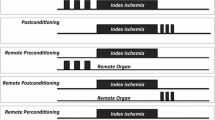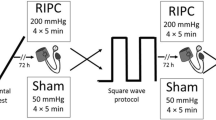Abstract
Purpose
Exercise induces a cardioprotective effect referred to as “preconditioning”. Whether the preconditioning impacts upon the cardiac troponin T (cTnT) response to subsequent exercise bouts is unclear. This study investigated the effects of an initial exercise bout, a second exercise bout 48 h later, as well as subsequent exercise every 48 h for 4 days or a single identical exercise bout after 8 days of inactivity gap on cTnT response to acute exercise.
Methods
Twenty-eight sedentary overweight young women were randomly assigned to either six bouts of exercise each separated by 48 h or three bouts of exercise with 48 h between the first two bouts and 8 days between the second and third bouts. All exercise bouts were identical (60% \(\dot {V}{{\text{O}}_{2{\rm max} }}\), 200 kJ) and the total testing period (10 days) was the same for both groups. cTnT was assessed before and after the 1st, 2nd, and final exercise bouts.
Results
cTnT increased (129%, P < 0.05) after the first bout of exercise in both groups (peak post-exercise cTnT, median [range], ng l−1: 3.43[< 3.00−27.26]) with no between-group differences in the response. The second exercise bout had no significant (P > 0.05) effect on post-exercise cTnT (< 3.00[< 3.00−21.96]). The final exercise bout resulted in an increase (190%, P < 0.05) in cTnT (4.35[< 3.00−13.05]) in both groups.
Conclusions
A single bout exercise resulted in a temporary blunting of cTnT response to acute exercise 48 h later. The effect of exercise preconditioning was not preserved, regardless of whether followed by repeated exercise every 48 h or a cessation of exercise for 8 days.


Similar content being viewed by others
Abbreviations
- 3BOUTS:
-
Three repeated bouts of exercise
- 6BOUTS:
-
Six repeated bouts of exercise
- ANOVA:
-
Analysis of variance
- cTn:
-
Cardiac troponin
- cTnI:
-
Cardiac troponin I
- cTnT:
-
Cardiac troponin T
- CVD:
-
Cardiovascular disease
- HR:
-
Heart rate
- RPE:
-
Rating of perceived exertion
- \(\dot {V}{{\text{O}}_{2{\rm max} }}\) :
-
Maximal oxygen uptake
References
Daniels LB (2013) The enemy of good?: making the most of highly sensitive troponin assays. J Am Coll Cardiol 61:1914–1916. https://doi.org/10.1016/j.jacc.2013.01.065
Eijsvogels T, George K, Shave R, Gaze D, Levine BD, Hopman MT, Thijssen DH (2010) Effect of prolonged walking on cardiac troponin levels. Am J Cardiol 105:267–272. https://doi.org/10.1016/j.amjcard.2009.08.679
Eijsvogels TM, Hoogerwerf MD, Maessen MF, Seeger JP, George KP, Hopman MT, Thijssen DH (2015) Predictors of cardiac troponin release after a marathon. J Sci Med Sport 18:88–92. https://doi.org/10.1016/j.jsams.2013.12.002
Fu F, Nie J, Tong T (2009) Serum cardiac troponin T in adolescent runners: effects of exercise intensity and duration. Int J Sports Med 30:168–172. https://doi.org/10.1055/s-0028-1104586
Giannitsis E, Kurz K, Hallermayer K, Jarausch J, Jaffe AS, Katus HA (2010) Analytical validation of a high-sensitivity cardiac troponin T assay. Clin Chem 56:254–261. https://doi.org/10.1373/clinchem.2009.132654
Gresslien T, Agewall S (2016) Troponin and exercise. Int J Cardiol 221:609–621. https://doi.org/10.1016/j.ijcard.2016.06.243
Hamilton KL, Staib JL, Phillips T, Hess A, Lennon SL, Powers SK (2003) Exercise, antioxidants, and HSP72: protection against myocardial ischemia/reperfusion. Free Radic Biol Med 34:800–809
Klinkenberg LJ, van Dijk JW, Tan FE, van Loon LJ, van Dieijen-Visser MP, Meex SJ (2014) Circulating cardiac troponin T exhibits a diurnal rhythm. J Am Coll Cardiol 63:1788–1795. https://doi.org/10.1016/j.jacc.2014.01.040
Kong Z, Nie J, Lin H, George K, Zhao G, Zhang H, Tong TK, Shi Q (2017) Sex differences in release of cardiac troponin T after endurance exercise. Biomarkers 22:345–350. https://doi.org/10.1080/1354750X.2016.1265007
Lavie CJ, McAuley PA, Church TS, Milani RV, Blair SN (2014) Obesity and cardiovascular diseases: implications regarding fitness, fatness, and severity in the obesity paradox. J Am Coll Cardiol 63:1345–1354. https://doi.org/10.1016/j.jacc.2014.01.022
Legaz-Arrese A, Lopez-Laval I, George K, Jose Puente-Lanzarote J, Castellar-Otin C, Reverter-Masia J, Munguia-Izquierdo D (2015a) Individual variability of high-sensitivity cardiac troponin levels after aerobic exercise is not mediated by exercise mode. Biomarkers 20:219–224. https://doi.org/10.3109/1354750X.2015.1068851
Legaz-Arrese A, Lopez-Laval I, George K, Puente-Lanzarote JJ, Mayolas-Pi C, Serrano-Ostariz E, Revilla-Marti P, Moliner-Urdiales D, Reverter-Masia J (2015b) Impact of an endurance training program on exercise-induced cardiac biomarker release. Am J Physiol Heart Circ Physiol 308:H913–H920. https://doi.org/10.1152/ajpheart.00914.2014
Legaz-Arrese A, Lopez-Laval I, George K, Puente-Lanzarote JJ, Moliner-Urdiales D, Ayala-Tajuelo VJ, Mayolas-Pi C, Reverter-Masia J (2015c) Individual variability in cardiac biomarker release after 30 min of high-intensity rowing in elite and amateur athletes. Appl Physiol Nutr Metab 40:951–958. https://doi.org/10.1139/apnm-2015-0055
Miller LE, McGinnis GR, Peters BA, Ballmann CG, Nanayakkara G, Amin R, Quindry JC (2015) Involvement of the delta-opioid receptor in exercise-induced cardioprotection. Exp Physiol 100:410–421. https://doi.org/10.1113/expphysiol.2014.083436
Nie J, Close G, George K, Tong T, Shi Q (2010) Temporal association of elevations in serum cardiac troponin T and myocardial oxidative stress after prolonged exercise in rats. Eur J Appl Physiol 110:1299–1303. https://doi.org/10.1007/s00421-010-1604-6
Nie J, George KP, Tong TK, Gaze D, Tian Y, Lin H, Shi Q (2011a) The Influence of a half-marathon race upon cardiac troponin T release in adolescent runners. Curr Med Chem 18:3452–3456
Nie J, George KP, Tong TK, Tian Y, Shi Q (2011b) Effect of repeated endurance runs on cardiac biomarkers and function in adolescents. Med Sci Sports Exerc 43:2081–2088. https://doi.org/10.1249/MSS.0b013e31821d4a82
Nie J, Tong TK, George K, Fu FH, Lin H, Shi Q (2011c) Resting and post-exercise serum biomarkers of cardiac and skeletal muscle damage in adolescent runners. Scand J Med Sci Sports 21:625–629. https://doi.org/10.1111/j.1600-0838.2010.01096.x
Nie J, Zhang H, Kong Z, George K, Little JP, Tong TK, Li F, Shi Q (2018) Impact of high-intensity interval training and moderate-intensity continuous training on resting and postexercise cardiac troponin T concentration. Exp Physiol 103:370–380. https://doi.org/10.1113/EP086767
Sedaghat-Hamedani F, Kayvanpour E, Frankenstein L, Mereles D, Amr A, Buss S, Keller A, Giannitsis E, Jensen K, Katus HA, Meder B (2015) Biomarker changes after strenuous exercise can mimic pulmonary embolism and cardiac injury—a metaanalysis of 45 studies. Clin Chem 61:1246–1255. https://doi.org/10.1373/clinchem.2015.240796
Thijssen DHJ, Redington A, George KP, Hopman MTE, Jones H (2018) Association of exercise preconditioning with immediate cardioprotection: a review. JAMA Cardiol 3:169–176. https://doi.org/10.1001/jamacardio.2017.4495
Tian Y, Nie J, Huang C, George KP (2012) The kinetics of highly sensitive cardiac troponin T release after prolonged treadmill exercise in adolescent and adult athletes. J Appl Physiol 113:418–425. https://doi.org/10.1152/japplphysiol.00247.2012
WHO (2000) The Asia-Pacific perspective: redefining obesity and its treatment. Health Communications Australia, Sydney
Wu AH, Apple FS, Gibler WB, Jesse RL, Warshaw MM, Valdes R Jr (1999) National Academy of Clinical Biochemistry Standards of Laboratory Practice: recommendations for the use of cardiac markers in coronary artery diseases. Clin Chem 45:1104–1121
Zhang H, Tong TK, Qiu W, Zhang X, Zhou S, Liu Y, He Y (2017) Comparable effects of high-intensity interval training and prolonged continuous exercise training on abdominal visceral fat reduction in obese young women. J Diabetes Res. https://doi.org/10.1155/2017/5071740
Acknowledgements
This work was supported by the National Natural Science Foundation of China (Grant No. 31771319).
Author information
Authors and Affiliations
Contributions
HZ, JN, ZK and KG conceived and designed research. HZ, JN, ZK, WC, XZ and ZZ conducted experiments. HZ, JN, ZK and KG analyzed data. HZ, JN, ZK and KG wrote the manuscript. All authors read and approved the manuscript.
Corresponding author
Ethics declarations
Conflict of interest
The authors declare that they have no conflict of interest.
Ethical approval
All procedures performed in studies involving human participants were in accordance with the ethical standards of the institutional research committee and with the 1964 Helsinki declaration and its later amendments or comparable ethical standards.
Additional information
Communicated by I. Mark Olfert.
Publisher’s Note
Springer Nature remains neutral with regard to jurisdictional claims in published maps and institutional affiliations.
Rights and permissions
About this article
Cite this article
Zhang, H., Nie, J., Kong, Z. et al. The cTnT response to acute exercise at the onset of an endurance training program: evidence of exercise preconditioning?. Eur J Appl Physiol 119, 847–855 (2019). https://doi.org/10.1007/s00421-019-04074-0
Received:
Accepted:
Published:
Issue Date:
DOI: https://doi.org/10.1007/s00421-019-04074-0




